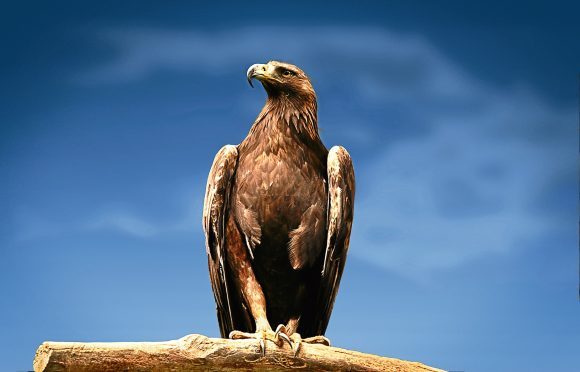I am a newcomer to the eagle glen. My 40 years acquaintance with the place is only a few more years than the lifespan of a single golden eagle, assuming it is given the opportunity to die quietly of old age.
It happens sometimes, although in those 40 years I have known eagles from this eyrie that have been shot, poisoned, starved in an unchecked crow trap, and eagle chicks and eagle eggs stolen from the nest.
Yet the birds remain loyal to the nest site. There have been golden eagle generations here since the landscape settled down after the last Ice Age, so probably the better part of 10,000 years.
The eyrie buttress wears their name like a badge: Creag na h-Iolaire is what it says on maps.
For the benefit of all those who protest loudly in this newspaper and elsewhere that keeping the Gaelic language alive in the 21st Century is an outrageous extravagance or an academic indulgence and we should all speak American English because it’s easier to spell plow with an ow than an ough, Creag na h-Iolaire means Eagle Crag.
The English language did not name the eagle’s landscape, Gaelic did, and it still does. You find that name all across the Highlands and Islands, wherever eagles have been accustomed to nest or to roost; or because from where the namers lived the crag in question looked like an eagle.
Not the least of the services the Gaelic language confers on the 21st Century is the nature of the relationship between our ancestors and their landscape.
Newcomers
And for the benefit of all those who protest equally loudly that eagles should only be tolerated in the landscape if they behave the way people who work the land think they should behave rather than the way nature thinks they should behave, you are newcomers to the land too.
You and your predecessors and your determination to subdue nature rather than work with it are responsible for imposing a singularly unnatural regime on landscapes that eagles occupied before your species had been invented.
MacAlpine’s Gaelic-English Dictionary of 1832 has an interesting entry. It says simply: ‘Fir-eun, n.m., the eagle, the real bird.’
Now there is an accolade from the old inhabitants of eagle landscapes, there is a hint of the kind of reverence for eagles that once existed among the natives of landscapes like this one.
Affinity
The process of reaffirming the eagles’ affinity with the glen for one more year, one more nesting season, has already begun, even though the glen is midwinter-bare and its burns and rock faces are hung with icicles and old snow and its river sluggish with ice.
From the first exuberant display flights that proclaim the pair-bonding rituals of the resident adults, to the first stuttering flight of a new chick sometime in midsummer, is a relentless and spectacular endeavour of wildest nature that consumes more than half the year.
Watching it over years taught me to think differently about mountain country, taught me to explore different ways of writing about nature.
Whenever you make a detailed study of a single species in a single landscape, you get to know not just the species itself but all its neighbours and fellow-travellers.
A sense of repeating patterns and of natural rhythms is slowly revealed, and understanding begins to take shape of how nature works and what it needs to fulfil its potential.
The upper part of the glen has softened in the time I have known it, a consequence of reversing a decision to plant conifers in the late 1970s to make life easier for eagles in the late 1990s.
Prosperity
The mountain birchwoods in particular have prospered, and in the absence of serious grazing pressure, the grass in the best of our summers is a deep green and waist-high sheen.
It is tempting to contemplate such fragrant growth and associate it with qualities more redolent of an alpine meadow in Switzerland.
But in reality this is the southern mountains of the Highlands reverting to type.
This is a Scottish landscape tradition too; we have just lost sight of it for too long.
It does me good during these midwinter treks to the eagle glen to remember a summer day sitting alone by the burn, stripped to the waist, knowing that at any moment one or both of the adult eagles would rise above the skyline and put their silhouettes on the day.
At such moments, it is possible to feel an almost absurd surge of optimism for those eagles, for wildness.
All it takes is time.
That and the liberation of human imagination from old constraints, the way the memory of a benevolent summer liberates a cold-and-rain-drenched human spirit and puts the scent of honey in the air.
That, and the acknowledgement that we are the newcomers in the eagle glen.










